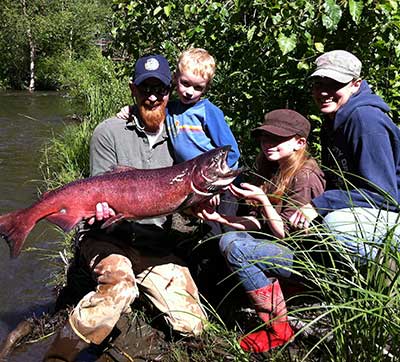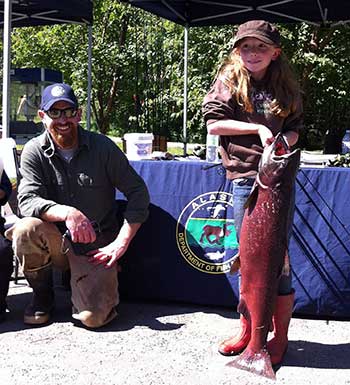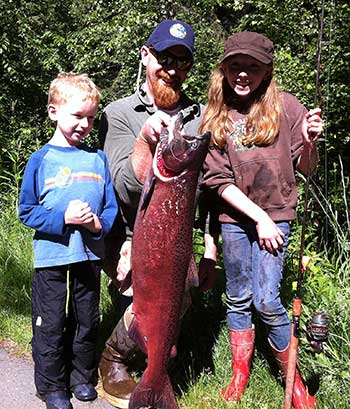Alaska Fish & Wildlife News
August 2014
Taking the Five Salmon Family Challenge

The other night I stood next to my nine-year-old daughter knee deep in mud. We were among many anglers at a popular spot along the bank, watching the lower stretch of Ship Creek spill into the sea. We each held a fishing rod, soaking cured salmon roe and fighting off the urge to set the hook on every small strike. The tide was at ebb. What fish that had come in on the incoming tide were now turning to head for salt, like the river was somehow exhaling reluctant kings too shy for their final return.
Strike; she sets the hook, slips in the mud, falls and catches herself with one hand. I reach down and lift her to her feet. She reels aggressively for a moment, then realizes with disappointment the fish is gone and she’s covered in mud. She reels in, hands me the rod and proceeds to wipe her soiled hand on my Carhartts. I re-bait the hook with fresh eggs and step back to give her room to cast. It was nearing 10 p.m. on a Tuesday. My wife and my five-year-old son who had been fishing with us earlier were undoubtedly at home preparing to call it a night. We fished, each of us occasionally working to free our boots from the slop at our feet, and eagerly awaited the slight pull at the end of our lines.
***
The way I remember it, the first fish I ever caught was an 18 inch brown trout. I took the fish on a borrowed rod and reel set up, fishing with my step-father during the closing moments of an ornamental western evening. I recall the slow pace of the water, threading a quivering grasshopper on the hook, watching the moment the bobber shot beneath the surface and the pretzel like way the fish writhed on the muddied bank. The rest of the experience faded from recollection long ago.
This memory of what I assume to be my first fish on rod and reel is centered at the crossroads of truth and the fallible mind of an angler. In all likelihood, the experience is a figment. Or, perhaps only part of the memory is true. I don’t remember how old I was. I’m sure it wasn’t the first fish I ever caught. I highly doubt it was 18 inches and for all I know it was a carp, not a trout. And while the first sentence penned in my book of fin, hook, water and scale may in fact be a fictional mental relic, it’s an acceptable falsehood for someone who has grown to understand that there are certain aspects about angling that have nothing to do with catching fish.
I won’t begin to ruminate on what it is about a fish and sport fishing that draws us so intently to the water. To many of us, quite simply it’s food. Fish are good protein. To others, it’s a combination of gathering food while enjoying the outdoors. Still to others, the reason to fish goes beyond a winter’s supply of food and commonplace explanation. Maybe fishing is an experience that is best defined as a return. To what, though?
In the book “Eels” by James Prosek, the author writes, “We allow ourselves to believe that nature can be explained. In the process we confine nature to those explanations. The eels, through their simplicity of form, their preference for darkness, and their grace of movement in the opposite direction of every other fish, have helped me to see things for which there is no easy classification, things that can’t be quantified or solved, and get to the essence of experience. They have been my way back.”
***
My kids began fishing before they could walk. They had to. My family depends on salmon as a valuable food source. We harvest what we will use, preserving the tasty flesh in various ways and delighting in the bounty throughout the year. We know how blessed we are to live in a place that allows us such a lifestyle. I vividly remember my wife fishing on the Klutina River for sockeye one evening with my then eight-month-old son strapped to her back, fast asleep. Like many Alaskan kids, they will grow up around fish. They will learn when and how to identify and target certain species of salmon. They will learn to cut, fillet, preserve and package. Whether or not either of them develops the same adoration for fishing that I have is yet to be known. Maybe. Maybe not. Hopefully they will.
We always make time during the short summers to go after salmon. Here in Southcentral, we don’t have to go too far to find great fishing. We’ll often go after I get home from work to any number of our favored fishing spots. My kids’ attention span is often short when the fishing is slow. But it only takes one good strike to get them focused. We also plan longer trips to specific locations where we often camp and enjoy fishing. We’re familiar with many of the state’s roadside locations that offer great fishing opportunities, and year by year we always discover a new place to go.

This year my family is taking on a new challenge: the Five Salmon Family Challenge.
This is a relatively new program being offered by the Alaska Department of Fish and Game. The program offers a certificate of recognition to any sport fish angling “family” who catches and documents all five species of Pacific salmon in Alaska. As we work to check off the different species we catch, my family is realizing it’s truly a challenge that takes a bit of dedication. We took care of the sockeye on a recent trip to the Russian River. We’ve been trying to hook up with a king, but thus far have been unsuccessful. There’s still time. Besides, if we don’t manage to land a king in flowing waters this summer, we will travel to a local stocked lake and target landlocked Chinook.
This year is expected to bring large numbers of pink salmon to Southcentral waterways, and my kids have more fun catching these lively fish than most others. We’ll target coho in the fall, and last but certainly not least will be the severely underappreciated chum. For any angler who would rather turn away from hooking a chum, I’d encourage another look at this hearty salmon. In my opinion, chum salmon are, pound-for-pound, the toughest fighting salmon of them all. They’ve got the endurance of a sockeye and the acrobatics of a coho. Once in freshwater, the chum turns rather quickly, developing those tell-tale calico marks that make it so easy to identify. I assume it’s this rapid change in physical characteristics and muscular tissue that, for me anyway, makes them less palatable as table fare.
The Five Salmon Family Challenge does not require anglers to harvest a fish. Good photos, showing the anglers and the species of salmon will allow ADF&G staff to easily verify that all parameters of the challenge have been met before issuing a certificate. Anglers are free to practice catch-and-release, and in some waterways during certain times of the year, that may be required for certain species. Anglers are encouraged to familiarize themselves with current regulations when targeting their preferred species. Photos showing any evidence of illegal sport fishing activity will not be considered.
***
The Alaska Department of Fish and Game sponsors several Youth-Only fisheries throughout Southcentral Alaska. These fisheries offer anglers 15 years of age and younger an opportunity to fish on specific days and for specific species in selected waterways. Youth-Only fisheries are approved by the Alaska Board of Fisheries and are written into sport fishing regulation. Information on the various Youth-Only fisheries in Southcentral can be found on page 22 of the Southcentral sport fishing regulation book.
My kids were among the many who participated in the Campbell Creek Youth-Only fishery in Anchorage on June 28. It rained for nearly a week prior to the event, causing the creek to rise and visibility to be less than ideal. But on the day of the event, the sun broke out and it was a perfect day to be on the water.
The night before, my daughter agreed that she’d be willing to get up early as I wanted to be out of the house around 5:30 a.m. The Youth-Only fishery is open from 6 a.m. to 10 p.m. during the last Saturday and Sunday in June. It only took a slight shove as she lay sleeping to rouse her from a deep slumber. She jumped up, ran upstairs, ate breakfast and had her gear on before I finished my first cup of coffee. The commotion woke my wife and son. It took a little persuasion to convince my wife it was a good idea for all of us to venture to the Youth-Only fishery, but at around 6 a.m. we were on our way.
Campbell Creek spreads itself like an erratic vein across the frenzied pulse of Anchorage. It lays subtle against traffic and high-rise, guarded by thick foliage, hidden in plain view. The Campbell Creek Greenbelt parallels sections of the creek where runners, anglers, bikers, dog walkers, and everyday summer recreationalists move under green canopies. It’s easy to convince yourself that the city is long gone as you walk the Greenbelt. It’s quiet.
Campbell Creek is only open to sport fishing for king salmon during the Youth-Only fishery. Certain sections of the creek open to fishing on June 15 to trout and Dolly Varden, and there is opportunity to target coho in open areas from July 14 to October 1. Bears frequent the upper stretches, filling themselves on spawning salmon in an area that gets little angling pressure.
As soon as we parked, my daughter opened the truck door and jumped out. I gathered my things inside the cab and listened as she grabbed a rod from the back. It was early, even for the common barrage of mosquitoes. I watched as families with young anglers walked by. I was slightly unfamiliar with the area which we intended to fish, so I approached the creek and began looking for deep holes, cutbanks, and overhangs. The water was a bit murky.

I positioned my daughter slightly downstream of a nice hole and watched as she sent the cured roe to the depths. It didn’t take long and her rod tip began to react. “Wait till he takes it,” I said. She waited. Nothing. “Reel in,” I said. “Maybe it got your bait.” She picked up the rod, and began to reel in. Almost instantly the tip began to shake and she screamed, “I think I’ve got something!” And she did.
I watched as she fought the fish, allowing herself to be pulled forward as the pressure on the rod increased. She nearly went in. But after a short battle, I reached down and cradled the small jack king in my hand. I looked up at a smiling face and asked, “Would you like to keep it?” Anglers can retain up to five king salmon under 20 inches in length and can retain only one king salmon 20 inches or greater in length. “Yes!” she said.
The Alaska Department of Fish and Game was on site from 10 a.m. to 1 p.m. at the Campbell Creek Youth-Only fishery. Staff fielded questions, loaned rods and tackle, and offered bait to those who needed it. Staff set up a weigh-in board and marked the fish that were brought in to be weighed. Staff weighed my daughter’s jack and noted on the board that the first fish to come in weighed 1 lb. 4 oz. We could only go up from there.
My family hung around the ADF&G tent for a while and traded information with my colleague, who has fished extensively on Campbell Creek. I took him up on his offer to show us a few holes close by that might be holding kings. It was a short walk off the Greenbelt path to a very nice looking hole where I baited her hook and let her cast. I could see there were two separate trees that had fallen into the hole, which I knew would be an issue.
Strike. She pauses. Another strike. “Dad, what do I do?” The rod tip doubles over. As she pulled the rod back and began reeling in, I saw a faintly tinted silver and red body turn in the current. The fish was big. She held on to the rod as the fish pulled line from the reel. I stood behind her and coached her as the fish used the push of the current to its advantage. After a minute or two, the fish swam beneath a downed tree and the 40 pound test monofilament snapped like an incomplete thought.
She shrugged the loss off.
Minutes later my colleague returned, followed by my wife and son. I conveyed the story of loss and admitted there was nothing we could do once the king took cover under the snag. He suggested we abandon the hole and walk to another location that could be holding kings. I tied a new leader on my daughter’s line and we set out to try one more time. We agreed that if we didn’t hook anything in the next hole we would stop fishing for the day.
Sometimes, a king’s strike is ironic. Too small. Left open ended. Not aggressive enough for the fish’s size. The small flutter of a rod tip doesn’t make sense. Big kings can hit bait like the erratic hands of tiny thieves steal small things.
My daughter watched the tip of her rod jostle. This strike wasn’t as obvious as the others. She hesitated, not knowing if it was worth setting the hook. I watched, hesitant to tell her to set the hook. I thought a small trout was filling itself on cured roe. She submitted to the enthusiastic twitch and set the hook. We all knew immediately that she had hooked another big king. This was the third big king she hooked that day. We were determined to land this one.
The fight lasted for about five minutes. I was there to help her control the rod, but she did the majority of the work, turning the fish against the current and listening to the coaching from my colleague who netted the fish. She was exhausted from the battle, but overcome with enthusiasm. We posed for photos streamside and then walked back to the ADF&G booth to show the fish. The fish weighed just under 20 pounds.
We’ve now caught and documented two of the required five species of salmon and hope to complete the Five Salmon Family Challenge by the end of the season. It’s not recognition we’re after, it’s that we are sharing in an experience, each determining what fin, water and scale mean. We’re fishing. Together.
More information on the Five Salmon Family Challenge can be found here.
Ryan Ragan is an Information Officer with the ADF&G Sport Fish Division in Anchorage.
Subscribe to be notified about new issues
Receive a monthly notice about new issues and articles.
